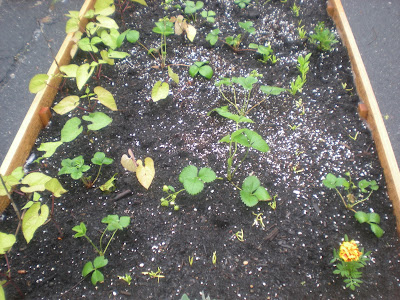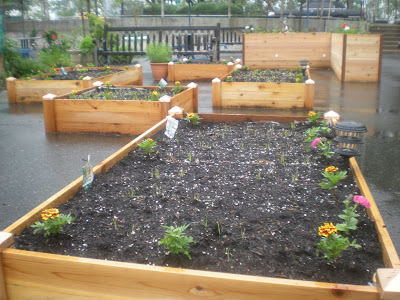The first meeting of the steering committee for the Bard Garden was held on August 9th. Parents from the Bard Garden Committee, BHSEC teachers and administrators, and our "edible schoolyard" consultants attended. Among other things we learned of exciting plans by several professors and teachers to use the garden as a base for lessons in biology, philosophy, health and food history and justice.
The next steering committee meeting will be held the week of September 18th. If you are a parent of a current or incoming BHSEC student we'd love to have you join us. We need new people and new ideas to help steer ongoing plans. If you are interested in attending this meeting leave a comment below and someone will get back to you with the exact time and location of the meeting.
Scroll down and continue reading this post to get a brief overview of our meeting on August 9th.
 Attendees were BHSEC Principal Michael Lerner, Admissions Coordinator Quincy Robinson (both shown above) , Special Projects Manager Kristi Powell-Grenfell, parents of BHSEC alumna and Garden Committee members Sonia Laudi and Karen Hatch, Biology Professor Jennifer Cordi, and "edible schoolyard" consultants Tess Diamond and Cerise Mayo.
Attendees were BHSEC Principal Michael Lerner, Admissions Coordinator Quincy Robinson (both shown above) , Special Projects Manager Kristi Powell-Grenfell, parents of BHSEC alumna and Garden Committee members Sonia Laudi and Karen Hatch, Biology Professor Jennifer Cordi, and "edible schoolyard" consultants Tess Diamond and Cerise Mayo.
 We discussed ideas, plans and concerns about the garden. Keeping the soil healthy and irrigation are things we will be attending to. In addition, the expansion of the planting beds will continue this fall and we are researching choices for a permanent sprinkler system.
We discussed ideas, plans and concerns about the garden. Keeping the soil healthy and irrigation are things we will be attending to. In addition, the expansion of the planting beds will continue this fall and we are researching choices for a permanent sprinkler system.
Tess Diamond and Cerise Mayo, of The Agrarian Academy (which is a working title for their newly formed organization) spoke about their plans for incorporating the garden into the academics at BHSEC. Tess will be teaching a Health elective called "Food Politics and Systems" at BHSEC in the fall. The curriculum will include food history, food justice, botany, and nutrition and health.
Professor David Clark has plans to use the garden to teach a class centered around a philosopher who gave plants Latin names. Biology professor Jennifer Cordi has plans to have students test the DNA of local honey--hopefully from neighborhood rooftop hives--to find out which plants the bees actually visited to produce the honey (is clover honey really made from clover, for example).

 It is important that BHSEC students take ownership of the garden and yard in order for it to be sustainable. Last year more students used the yard for relaxation and recreation than ever before. This year students will have more opportunities to work on garden projects and to make choices about what gets planted and how the yard is arranged. With the incorporation of the garden into the curriculum the garden is sure to be woven more tightly into the culture of BHSEC this year.
It is important that BHSEC students take ownership of the garden and yard in order for it to be sustainable. Last year more students used the yard for relaxation and recreation than ever before. This year students will have more opportunities to work on garden projects and to make choices about what gets planted and how the yard is arranged. With the incorporation of the garden into the curriculum the garden is sure to be woven more tightly into the culture of BHSEC this year.
We have some grant money and some potential partnerships to make. Who knows where this will take us. Perhaps someday Bard will have it's own beehive and chickens too! (You never know!)
Again--if you are interested in helping out in the garden or joining the steering committee, it's a fun place to work and we welcome you. Have a look at the entirety of this blog to see how far the garden has come from it's beginning.


















































